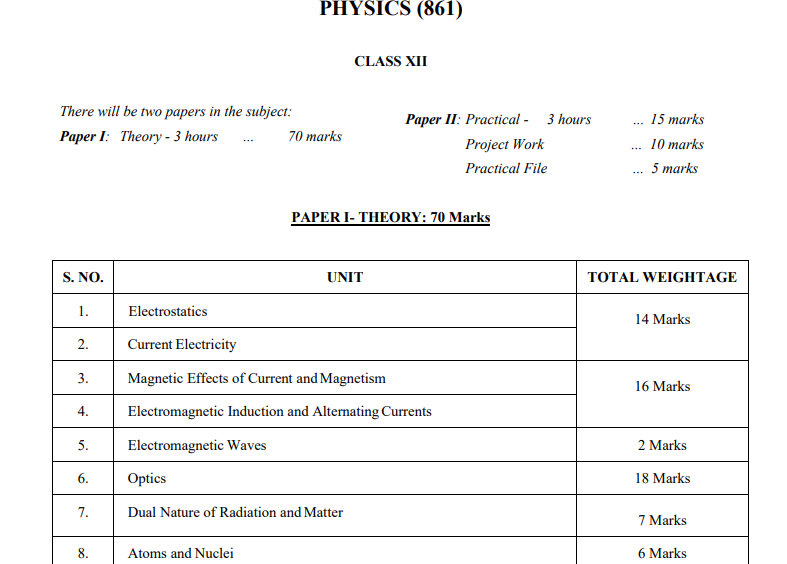The ISC Class 12 Physics Syllabus 2025-26 is designed to equip students with a deep understanding of core physics principles and their practical applications. With an emphasis on foundational concepts such as electromagnetism, optics, and modern physics, the syllabus prepares students for advanced studies in science and engineering. The inclusion of hands-on practical work ensures that students not only grasp theoretical knowledge but also develop critical laboratory skills. By combining conceptual learning with project-based work, the syllabus fosters analytical thinking, problem-solving, and scientific inquiry.
ISC Class 12 Physics Syllabus 2025-26
The ISC Class 12 Physics syllabus for the academic year 2025-26 is designed to offer students a comprehensive understanding of both theoretical concepts and practical applications. The syllabus is divided into two papers: Paper I (Theory) carrying 70 marks and Paper II (Practical) carrying 15 marks. Additionally, 10 marks are allotted for project work and 5 marks for maintaining a practical file. The theory portion is divided into nine major units, covering essential topics in electricity, magnetism, optics, modern physics, and more.
Paper I: Theory – 70 Marks
The theory paper consists of the following units and their weightage:
| S.No. | Unit | Weightage (Marks) |
|---|---|---|
| 1 | Electrostatics | 14 |
| 2 | Current Electricity | |
| 3 | Magnetic Effects of Current and Magnetism | 16 |
| 4 | Electromagnetic Induction and Alternating Currents | |
| 5 | Electromagnetic Waves | 2 |
| 6 | Optics | 18 |
| 7 | Dual Nature of Radiation and Matter | 7 |
| 8 | Atoms and Nuclei | 6 |
| 9 | Electronic Devices | 7 |
| Total | 70 Marks |
Topics Covered in Detail:
- Electrostatics:
- Study of electric charges, fields, Coulomb’s law, and Gauss’s theorem.
- Electric potential, potential energy, and capacitors.
- Application of concepts like electric dipoles, flux, and charge distribution.
- Current Electricity:
- Electric current, Ohm’s law, and factors affecting resistance.
- Study of Kirchhoff’s laws, Wheatstone bridge, and potentiometers.
- Understanding power, energy, and electrical circuits.
- Magnetic Effects of Current and Magnetism:
- Biot-Savart law, Ampere’s law, and Oersted’s experiment.
- Magnetic force on moving charges and current-carrying conductors.
- Concepts of galvanometers, solenoids, and magnetic field properties.
- Electromagnetic Induction and Alternating Currents:
- Faraday’s laws, self-induction, and mutual induction.
- Alternating current: RMS values, LCR circuits, and resonance.
- Transformers and their applications.
- Electromagnetic Waves:
- Displacement current, characteristics of electromagnetic waves.
- Introduction to the electromagnetic spectrum and its uses.
- Optics:
- Ray optics: Mirrors, lenses, refraction, dispersion, and optical instruments.
- Wave optics: Interference, diffraction, and Huygen’s principle.
- Dual Nature of Radiation and Matter:
- Study of the photoelectric effect, Einstein’s equation, and de Broglie’s hypothesis.
- Matter waves and wave-particle duality.
- Atoms and Nuclei:
- Rutherford and Bohr’s atomic models, energy levels, and spectra of hydrogen.
- Concepts of nuclear fission, fusion, and mass-energy relations.
- Electronic Devices:
- Energy bands in conductors, semiconductors, and insulators.
- Semiconductor diodes, rectifiers, and applications like LEDs, Zener diodes, and solar cells.
Paper II: Practical Work – 15 Marks
Practical experiments are crucial for understanding theoretical concepts and include:
- Experiments Based on Ray Optics: Measuring focal lengths of lenses and mirrors, studying refractive indices.
- Experiments Based on Current Electricity: Studying resistances, Wheatstone bridge, and potentiometers.
- Graph Work: Recording and analyzing data using graphs.
Students must maintain a detailed practical file with records of experiments and observations, which will be assessed by a visiting examiner.
Project Work and Practical File – 15 Marks
- Project Work (10 marks): Students will undertake either a theoretical project, an investigatory project, or create a working model based on a physics-related topic. The project will be evaluated based on the report’s quality, originality, and presentation.
- Practical File (5 marks): Students will be evaluated based on the completeness and accuracy of their practical file, which must contain all the completed experiments.
ISC Class 12 Physics Syllabus 2025-26 PDF Download
The ISC Class 12 Physics Syllabus 2025-26 can be downloaded in PDF format. The document includes a detailed breakdown of the theory, practical experiments, and project work, helping students prepare systematically for their exams. we have given the direct link to download the syllabus PDF below.
ISC Class 12 Physics Syllabus Click Here To Download PDF
Best Books for ISC Class 12 Physics Syllabus 2026
Some highly recommended books and study materials to cover the ISC Class 12 Physics Syllabus (2026) effectively, including textbooks, guides, and practice books, suitable for concept building, theory, numericals, and board-style questions:
1. Core Textbooks (Primary Study Material)
These are essential for detailed theory and understanding every topic in your syllabus.
Nootan ISC Board Physics (Part 1 & 2)
Comprehensive textbook aligned with the latest ISC Class 12 Physics syllabus
Covers theory + examples + practice questions as per board pattern
Good for concept clarity and school exam preparation
APC Understanding ISC Physics – Volume 1 & 2 (Combo)
Well-explained concepts with numericals
Helps build strong fundamentals
Covers full syllabus and typical board questions
2. Complete Study Guides (Theory + Practice)
Great for self-study, clear explanations, and covering both theory & questions.
Arihant ISC All-in-One Physics Class 12 (2026 Edition)
Complete guide with detailed theory + solved examples
Topic-wise & chapter-wise questions + board questions up to 2025
Excellent for both revision and deeper practice
3. Question Banks & Practice Workbooks
Perfect for exam-oriented practice, past papers, and pattern-based questions.
Oswaal ISC Physics Question Bank (Chapterwise & Topicwise)
1500+ Questions, including past board papers
Mind maps, revision notes & exam tips
Helps in mastering board-type questions and improving answer writing skills
📓 Oswal Gurukul Physics Most Likely Question Bank
Focuses on important probable questions for ISC boards
Includes MCQs, short answers, long answers, and solved papers
Very useful for last-minute revision and practice
4. Revision Notes & Quick Reference
Useful for fast revision before exams and clearing up key formulas/points.
Oswaal ISC Class 12 Physics Notes
Concise and comprehensive notes covering key concepts, formulae, and experiment details
Great for revision just before exams
Tips for Using These Books
Start with Textbooks: Read Nootan or APC thoroughly for theory and understanding.
Practice with Guides: Use Arihant All-in-One for solved examples and deeper concept building.
Board-Focused Practice: Solve Oswaal Question Bank & Most Likely books chapterwise.
Revise Smart: Use Oswaal Notes for last-minute formula & concept revision.
Summary of Best Choices
| Category | Best Options |
|---|---|
| Textbook | Nootan ISC Physics (Part 1 & 2), APC Understanding ISC Physics |
| Complete Study Guide | Arihant ISC All-in-One Physics |
| Question Bank / Practice | Oswaal ISC Question Bank, Oswal Gurukul Most Likely |
| Revision Notes | Oswaal ISC Physics Notes |
Related Post:
| ISC Class 12 Legal Studies Syllabus | ISC Class 12 Biology Syllabus |
| ISC Class 12 Chemistry Syllabus | ISC Class 12 Physics Syllabus |
| ISC Class 12 Maths Syllabus | ISC Class 12 English Syllabus |
FAQs on ISC Class 12 Physics Syllabus
1. What is the ISC Class 12 Physics syllabus for 2026?
The ISC Class 12 Physics syllabus includes major units such as Electrostatics, Current Electricity, Magnetism, Electromagnetic Induction & Alternating Currents, Electromagnetic Waves, Optics, Dual Nature of Matter and Radiation, Atoms & Nuclei, Electronic Devices, and Communication Systems. These topics form the core theory content of the board exam.
Practical work includes experiments in the lab, project work, and a practical file/record.
2. How is the Physics exam structured?
-
Theory Paper: 70 marks
-
Practical/Internal Assessment: 30 marks (15 marks for practicals, 10 marks for project work, 5 marks for practical file).
The theory question paper typically has:
-
Multiple-choice and one-mark questions
-
Short answer/2-mark questions
-
Long answer/3-mark and 5-mark questions
organized into Sections A–D.
3. What major topics are included in the theory syllabus?
Key units in the ISC Class 12 Physics syllabus include:
-
Electrostatics – electric charges, fields, capacitance
-
Current Electricity – resistance, Ohm’s law, Kirchhoff’s laws
-
Magnetic Effects of Current & Magnetism
-
Electromagnetic Induction & AC
-
Electromagnetic Waves
-
Optics – ray and wave optics, interference, diffraction
-
Dual Nature of Radiation & Matter
-
Atoms and Nuclei
-
Electronic Devices – semiconductors, diodes, transistors
-
Communication Systems (basics)
4. Is practical work compulsory? What does it include?
Yes, practical assessment is part of the syllabus and carries 30 marks. This includes:
-
Lab experiments (15 marks)
-
Project work (10 marks) — investigatory or model based
-
Practical file/record (5 marks) documenting experiments and observations.
5. Are there specimen papers available for practice?
Yes. CISCE releases specimen question papers for ISC 2026 that reflect the latest exam pattern and types of questions expected. These are extremely useful for practice and understanding question formats.
6. Are there any changes in the Physics syllabus for 2026?
The syllabus for 2025-26 has been updated in parts compared to earlier years, especially in modern physics and electronics units, though the core topics remain consistent. Official changes are published by CISCE.
7. How should marks be distributed in preparation?
While exact weightage can vary, past patterns show higher marks allocated to:
-
Optics, Electromagnetic Induction & AC
-
Electrostatics and Current Electricity
-
Magnetic Effects and Modern Physics
Understanding these trends helps in prioritizing revision.
8. Where can I find the official syllabus PDF?
You can download the official ISC Physics syllabus 2025-26 PDF (useful for the 2026 board exams) from the CISCE website under Publications / Syllabus section for Class 12.
9. When will the ISC Class 12 Physics board exam be held in 2026?
The ISC Class 12 exam schedule for 2026 has been announced with board exams starting in February 2026. Schools and students should check the official CISCE timetable for exact dates.
10. Any tips for preparing Physics for ISC boards?
-
Understand core concepts first, then solve numericals
-
Do specimen papers and past papers to familiarise with the pattern
-
Maintain a neat practical record and practise lab experiments
-
Focus revision on high-weightage units like Optics and Electricity.

